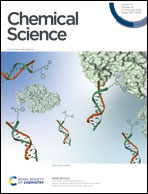Trifluoromethylarylation of alkenes using anilines†
Abstract
Nitrogen containing compounds, such as anilines, are some of the most widespread and useful chemical species, although their high and unselective reactivity has prevented their incorporation into many interesting transformations, such as the functionalization of alkenes. Herein we report a method that allows the trifluoromethylarylation of alkenes using anilines, for the first time, with no need for additives, transition metals, photocatalysts or an excess of reagents. An in-depth mechanistic study reveals the key role of hexafluoroisopropanol (HFIP) as a unique solvent, establishing a hydrogen bonding network with aniline and trifluoromethyl reagent, that is responsible for the altered reactivity and exquisite selectivity. This work uncovers a new mode of reactivity that involves the use of abundant anilines as a non-prefunctionalized aromatic source and the simultaneous activation of trifluoromethyl hypervalent iodine reagent.

- This article is part of the themed collections: Most popular 2023 organic chemistry articles and #MyFirstChemSci 2023


 Please wait while we load your content...
Please wait while we load your content...